How to build a chimney for a gas boiler: the order of
One of the necessary elements of any heating system in a private house is the boiler. This unit, regardless of the fuel used in it, must be installed in accordance with certain requirements, which guarantees the correctness and safety of its operation.
Consider how to equip the chimney for a gas boiler, as its installation instructions have some difficulties and nuances.

Design features
Before you install chimneys for gas boilers, you must select, purchase and install the device itself. The geometrical dimensions and other features of the chimney depend on the technical characteristics of the heating unit (see also the article Pipes and Fittings of Cross-linked Polyethylene: technical characteristics and installation features).
Consider the main nuances that should be considered when designing:
- The most common round designs. However, no one forbids the use of chimneys for boilers with a square cross section. The main requirement - the internal volume of the chimney must be larger than the combustion chamber of the boiler.

If you decide to stay on a round pipe, then to determine its internal volume, you need to know the internal diameter of the product. If it is not indicated on the marking, then for its calculation it is necessary to subtract the thickness of the pipe walls from the outside diameter.
Then the obtained values are substituted into the formula:
S =? * dinterior * L
Where dinterior - internal diameter of the pipe used;
L is the length of the chimney.
Note! The pipe for the chimney gas boiler should be wider than its outlet. Otherwise, it may be difficult to dock the boiler and the exhaust system.
- The height of the chimney depends on how far it will be from the ridge of the roof.
Here there is the following relationship:
- distance up to 1.5 meters - the upper cut of the pipe must be at least 50 cm longer;
- distance from 1.5 to 3 meters - the upper cut may be flush with the ridge or higher;
- a distance of more than 3 meters - in this case it is necessary to draw a line that will be 10 degrees below the horizontal line drawn through the highest point of the roof (the chimney section should not be lower than it).
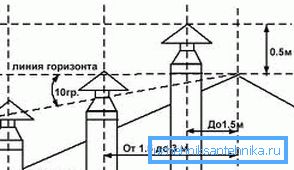
If, after calculating the internal volume of the pipe, it turned out that its diameter is not enough, you should not take much detail, since its price will be much higher. It is more advisable to just slightly increase the length of the structure.
Independent installation of the chimney
Choosing an accommodation option
Chimneys for gas boilers are not too complex systems, but when installing them with your own hands, you should take into account many nuances. Otherwise, the boiler will not function properly, which can lead to its breakdown, and in some cases - to the accumulation of exhaust gases in the room and the poisoning of people.
Before proceeding with the construction or installation, you should choose a place where the pipe will be arranged.
There are two main options:
- inside the house;
- outside the building.
Both the first and second options have their advantages and disadvantages.
Consider the features of indoor installation:
- if the chimney for a solid fuel boiler passes through heated rooms, it will not need to be further warmed;
- there is a danger of passing exhaust gases and their ignition;
- Chimney elements are more difficult to install and repair in the event of a breakdown.
If you decide to install the exhaust system outside the house, then there are also pros and cons:
- such a chimney is completely safe during operation;
- its design is less complicated to install;
- the pipe is easily repaired in case of breakage or depressurization;
- When choosing this option, you need to decide in advance what to insulate the boiler chimney, since its freezing in the winter period should not be allowed in any case.
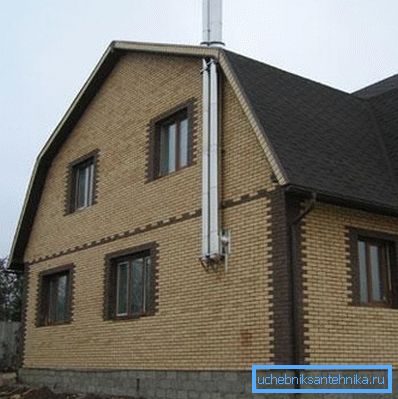
Components of the chimney
Pipe for removal of combustion products from the boiler, working on natural gas, consists of the following mandatory parts:
- an adapter connecting the outlet of the boiler with a discharge pipe;
- tee with a revision, equipped with a fitting, which is necessary to remove condensed moisture;
- fasteners - clamps and brackets;
- taps (if necessary) - they must be installed at a distance of at least 2 meters from the heating element, otherwise reduction of thrust is possible;
- transition pipes;
- pipes;
- conical tip.
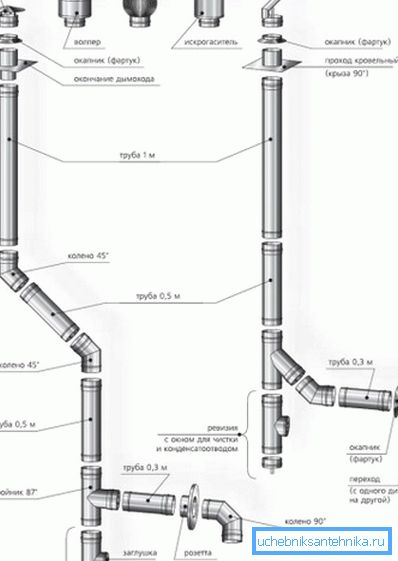
Note! The pipe for the gas boiler must have a conical end. Conventional baffles and caps are prohibited to install. In extreme cases, the cut may be left completely unprotected.
Installation of external chimney
The procedure for installing the exhaust gas exhaust system located outside the house is as follows:
- An adapter is put on the gas boiler pipe, which will pass through the wall. It should fit tightly into the masonry, so before making a hole several times carefully check all the dimensions and apply the markings.
- Through the wall of the chimney is displayed outside. All elements in contact with the brick (concrete) must be carefully insulated.
- Outside, the revision is fastened to the outgoing segment with a stub on it.
- Mounted pipe of the desired height. To do this, use the required number of pre-purchased links. The entire structure is fixed to the wall of the house with clamps with brackets. The distance between adjacent fasteners should not be less than 2 meters.
- As soon as the chimney reaches the desired height, a cone-shaped tip is put on the last element.
- All joints should be further tightened with hose clamps or steel wire.
- It is advisable to paint the pipe with paint that will protect the material from corrosion and give the pipe a more attractive appearance.
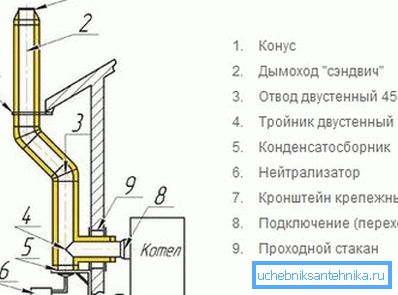
For the installation of the pipeline, it is desirable to use special multilayer pipes that do not require additional insulation. Otherwise, you should take care of the insulation yourself.
Installation of internal chimney
Unlike the previous construction, here before starting work it is necessary to carry out some preparatory activities:
- mark the floor decks and the roof in the places where the future chimney will pass;
- cut holes in the right places (all dimensions should be carefully checked so that the adapter pipes are inserted as tightly as possible).
The installation process itself is as follows:
- We attach to the outlet of the boiler a special adapter.
- A revision with a lid is attached to it, which is necessary for cleaning the chimney, and then the main support bracket with a metal sheet is installed, which will serve as the basis for the whole structure.
- We mount the pipe using direct components and other necessary adapters (elbows).
- In places where the pipe passes overlap, it is necessary to use special pipes.
- The points of entry and exit of the pipes from the ceiling should be protected with metal sheets, whose diameter should be slightly larger than the diameter of the chimney.
- All joints should be additionally strengthened with bolts or bolted with steel wire.
- The structure is fixed to the wall with the help of brackets.
- The upper cut of the pipe must be protected by a special cone-shaped nozzle that prevents precipitation and wind from getting inside the pipe.
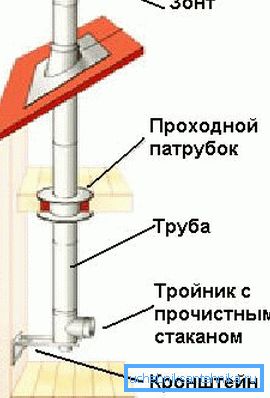
Chimney insulation measures
Locations where the exhaust system is in contact with materials that can easily ignite should be carefully insulated. To do this, the pipe used must be carefully coated on all sides with a basalt mat, insulated metal foil and a refractory mixture. Floorings can be additionally protected with mineral wool.
Do not forget to check the tightness of the seams. To do this, you can prepare a soap solution and apply it to the joints. The appearance of bubbles will indicate the presence of holes that must be sealed.
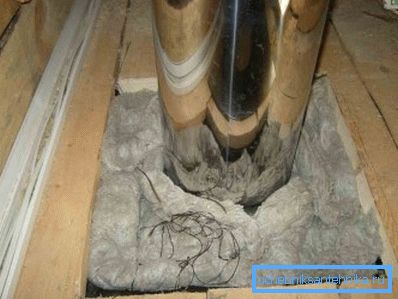
Conclusion
A chimney for a gas boiler in a private house is a very important detail. It depends not only on the correctness and efficiency of the heating system, but also on the safety of people in the house (see also the article Clutches for polyethylene pipes: 6 main types).
More details about the installation of various ventilation and exhaust systems can be found in the video in this article.